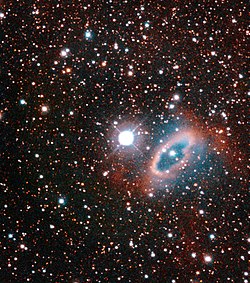
KNOWPIA
WELCOME TO KNOWPIA
Summary
HD 121228 is a blue supergiant star located in the constellation Centaurus. The star is noted for its close visual proximity to the planetary nebula SuWt 2.[9]
 | |
| Observation data Epoch J2000 Equinox J2000 | |
|---|---|
| Constellation | Centaurus |
| Right ascension | 13h 55m 52.322s[1] |
| Declination | −59° 22′ 16.45″[1] |
| Apparent magnitude (V) | 7.86[2] |
| Characteristics | |
| Spectral type | B1 Ib[3] |
| Apparent magnitude (U) | 7.34 |
| Apparent magnitude (B) | 8.00 |
| Apparent magnitude (V) | 7.86 |
| Apparent magnitude (R) | 8.88 |
| Apparent magnitude (G) | 7.7591 |
| Apparent magnitude (J) | 7.428 |
| Apparent magnitude (H) | 7.426 |
| Apparent magnitude (K) | 7.385 |
| Astrometry | |
| Proper motion (μ) | RA: −3.376[1] mas/yr Dec.: −1.300[1] mas/yr |
| Parallax (π) | 0.5846 ± 0.0260 mas[1] |
| Distance | 5,600 ± 200 ly (1,710 ± 80 pc) |
| Absolute magnitude (MV) | −5.32[4] |
| Details | |
| Mass | 7.0[5] M☉ |
| Radius | 19.6[6] R☉ |
| Luminosity | 4,124[7] L☉ |
| Surface gravity (log g) | 2.14[7] cgs |
| Temperature | 26,424[8] K |
| Age | 31.6[5] Myr |
| Other designations | |
| Database references | |
| SIMBAD | data |
References edit
- ^ a b c d e Vallenari, A.; et al. (Gaia collaboration) (2023). "Gaia Data Release 3. Summary of the content and survey properties". Astronomy and Astrophysics. 674: A1. arXiv:2208.00211. Bibcode:2023A&A...674A...1G. doi:10.1051/0004-6361/202243940. S2CID 244398875. Gaia DR3 record for this source at VizieR.
- ^ Zacharias, N.; Finch, C. T.; Girard, T. M.; Henden, A.; Bartlett, J. L.; Monet, D. G.; Zacharias, M. I. (2012). "VizieR Online Data Catalog: UCAC4 Catalogue (Zacharias+, 2012)". VizieR On-line Data Catalog. Bibcode:2012yCat.1322....0Z.
- ^ Houk, Nancy (1975). Michigan catalogue of two-dimensional spectral types for the HD stars. Vol. 1. Ann Arbor, Michigan: Dept. of Astronomy, University of Michigan. Bibcode:1975MSS...C01....0H.
- ^ Melnik, A. M.; Dambis, A. K. (2020). "Distance scale for high-luminosity stars in OB associations and in field with Gaia DR2. Spurious systematic motions". Astrophysics and Space Science. 365 (7): 112. arXiv:2006.14649. Bibcode:2020Ap&SS.365..112M. doi:10.1007/s10509-020-03827-0. S2CID 220128144.
- ^ a b Tetzlaff, N.; Neuhäuser, R.; Hohle, M. M. (2011). "A catalogue of young runaway Hipparcos stars within 3 kpc from the Sun". Monthly Notices of the Royal Astronomical Society. 410 (1): 190. arXiv:1007.4883. Bibcode:2011MNRAS.410..190T. doi:10.1111/j.1365-2966.2010.17434.x. S2CID 118629873.
- ^ Kervella, Pierre; Arenou, Frédéric; Thévenin, Frédéric (2022). "Stellar and substellar companions from Gaia EDR3". Astronomy & Astrophysics. 657: A7. arXiv:2109.10912. Bibcode:2022A&A...657A...7K. doi:10.1051/0004-6361/202142146. eISSN 1432-0746. ISSN 0004-6361.
- ^ a b Fouesneau, M.; Andrae, R.; Dharmawardena, T.; Rybizki, J.; Bailer-Jones, C. A. L.; Demleitner, M. (2022). "Astrophysical parameters from Gaia DR2, 2MASS, and AllWISE". Astronomy and Astrophysics. 662: A125. arXiv:2201.03252. Bibcode:2022A&A...662A.125F. doi:10.1051/0004-6361/202141828. S2CID 245837778.
- ^ Westin, T. N. G. (1985). "The local system of early type stars. Spatial extent and kinematics". Astronomy and Astrophysics Supplement Series. 60: 99. Bibcode:1985A&AS...60...99W.
- ^ "HD 121228". SIMBAD. Centre de données astronomiques de Strasbourg. Retrieved 2023-01-11.
See also edit
- Zeta Persei - Same spectral class


